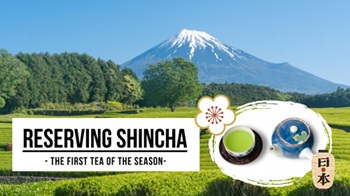Reserving Shincha - the first tea of the season
Slow Living, Japanese Style
Does life sometimes feel too fast? Experience the art of slow living with a touch of Japan.
Join online teacher Takane-sensei in this Japanese language learning blog and discover how Japanese wisdom can help you slow down and savor life more.
新茶の予約
Reserving Shincha

By TAKANE Yukiko

「今年も新茶が入ります。いかがですか?」 「はい、今年もお願いします。」 毎年2月下旬にお茶屋さんから電話があります。 予約をすると 5月初旬に色々な種類の新茶が5袋届きます。 我が家ではこれで1年分です。
今はペットボトルで色々なお茶が楽しめるので、 急須のない家庭も増えたとのこと。 新茶の袋を開けたときのやわらかな香りと、若々しい 茶葉に春を感じます。
忙しい毎日ですが、時には急須を使い、ゆっくり時間を 味わうのはいかがですか? 茶葉の袋の 茶畑の写真を目の前に広げながら、ズズーッと一口。 今年も1年お世話になります。
To listen to this blog, please watch our Youtube video.
新茶(しんちゃ)の予約(よやく)
「今年(ことし)も新茶(しんちゃ)が入(はい)ります。いかがですか?」 「はい、今年(ことし)もお願(ねが)いします。」 毎年(まいとし)2月(がつ)下旬(げじゅん)にお茶屋(ちゃや)さんから電話(でんわ)があります。 予約(よやく)をすると 5月(がつ)初旬(しょじゅん)に色々(いろいろ)な種類(しゅるい)の新茶(しんちゃ)が5袋(ふくろ)届(とど)きます。 我(わ)が家(や)ではこれで1年分(ねんぶん)です。
今(いま)はペットボトルで色々(いろいろ)なお茶(ちゃ)が楽(たの)しめるので、 急須(きゅうす)のない家庭(かてい)も増(ふ)えたとのこと。 新茶(しんちゃ)の袋(ふくろ)を開(あ)けたときのやわらかな香(かお)りと、若々(わかわか)しい 茶葉(ちゃば)に春(はる)を感(かん)じます。
忙(いそが)しい毎日(まいにち)ですが、時(とき)には急須(きゅうす)を使(つか)い、ゆっくり時間(じかん)を 味(あじ)わうのはいかがですか? 茶葉(ちゃば)の袋(ふくろ)の 茶畑(ちゃばたけ)の写真(しゃしん)を目(め)の前(まえ)に広(ひろ)げながら、ズズーッと一口(ひとくち)。 今年(ことし)も1年(ねん)お世話(せわ)になります。
Reserving Shincha
"We are getting some Shincha (or new tea) in again this year. Would you like to order some? " " Yes please, please put one order in for me this year too." >Every year in late February, I receive this call from our tea shop. If you put in an order, you will receive five bags of various types of new tea in early May. For our family, this is enough for one year.
Nowadays, more and more households do not have a teapot because they can enjoy a variety of teas in plastic bottles. The soft aroma of new tea leaves when you open the bag and the young leaves make you feel the spring season.
We are all busy in our daily lives, but how about sometimes using a kyusu (Japanese teapot) and take time to savor the flavor of the season? I can spread the picture of a tea plantation on a bag of tea leaves in front of me while slowly sipping my tea (making a zuu zuu slurping sound). I appreciate another year of this experience.
5月(がつ)初旬(しょじゅん)Early May
急須(きゅうす)teapot
茶葉(ちゃば)Tea leaves
味(あじ)わう to taste / savor
茶葉(ちゃば)の袋(ふくろ)tea leaf pouch
茶畑(ちゃばたけ)Tea plantation
Hajimemashite, I am Yukiko Takane.
I live in Chiba Prefecture. My hometown is near the ocean and is surrounded by rice fields - its a laid-back place. The sashimi and rice is really good here. My family home makes rice as well, so I usually help out during the harvest season. I may look weak, but actually I can lift a 30kg bag of rice.
In the past, I taught Japanese in Saipan and Cebu islands. The people I got to know there are precious to me. I am really looking forward to meeting you all in the online classrooms. I have been called 'Takani' Sensei or 'Okane' sensei by my students. Well, I am not a 'crab' nor am I 'money' - the name is Takane. Doozo yoroshiku onegaishimasu.
Try to use your newly learned vocabulary and phrases all the time in the lessons. Looking forward to meeting you all in class !


